Grilling steak is one of the most popular ways to cook this juicy, flavorful cut of beef. But how hot should the grill be for steak? It’s essential to get the temperature just right so that you can enjoy a perfectly cooked steak every time. This article will explain exactly how hot the grill should be for steak and why it matters.
We’ll also cover tips for getting your grill up to the ideal temperature and the best methods for checking that your steak is cooked through. So if you’re looking for perfect steaks every time, read on!
How Long Should You Preheat The Grill Before Cooking A Steak?
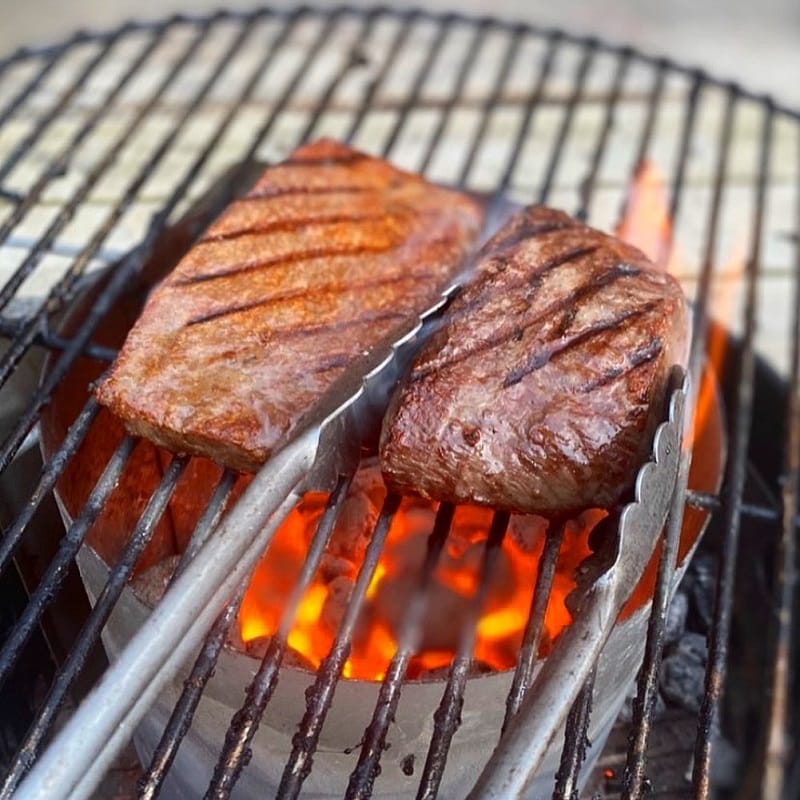
Preheating the grill is an essential step before cooking a steak. It is crucial for achieving that perfect sear and retaining the juice within the meat. The question is, how long should you preheat the grill before cooking a steak?
According to Weber, a leading grill manufacturer, preheating should take 10-15 minutes on high heat, with the lid closed, to reach temperatures of 450°F to 500°F for a perfect steak. Preheating is essential to ensure the food is cooked evenly and avoid sticking to the grates. The high heat will burn off the residue from previous grilling and sanitize the cooking surface. Preheating also helps maintain the temperature, which otherwise would reduce when food is placed on the grill.
How Hot Should The Grill Be For Steak?
When grilling steak, there is a common misconception that a high temperature is required to achieve a perfect sear. However, the effective searing range starts as low as 300°F and goes up to 500°F. Going beyond 500°F will cause the steak to dry out quickly and burn. Once the cooking grates have reached the correct temperature of 500°F to 550°F, placing the steak on the grill is time.
Sear for 2 to 3 minutes before moving the steak to indirect heat to finish cooking. Let the steak rest for 30% to 40% of the total cooking time before cutting into it, as this allows the juices to redistribute evenly throughout the meat. Following these guidelines, anyone can achieve a perfectly cooked steak on the grill.
How Long To Grill Steaks At 450?
Cooking a steak to perfection requires the right temperature and timing. To achieve the desired doneness of a steak grilled at 450°F, one must consider the thickness of the meat. A one-inch thick steak requires about four to five minutes of cooking time on each side for medium-rare doneness, while a two-inch thick steak may require up to 10 minutes on each side.
Using an instant-read thermometer, the internal temperature should read between 135°F to 145°F for medium-rare and medium-well doneness, respectively. Resting the steak for five minutes before slicing allows the juices to redistribute evenly throughout the meat, resulting in a juicy and flavorful steak.
Choosing high-quality meat with a thick cut is also crucial, as thinner steaks cook faster and may result in a less flavorful dish. The perfect sear can be achieved by ensuring that the surface of the steak is dry and salted at least one hour before cooking. Following these guidelines will guarantee a delicious and perfectly cooked steak every time.
How Hot Should The Grill Be For Flank Steak?

When grilling flank steak, one of the most crucial factors is the grill’s temperature. A grill that is too cold will result in tough and dry meat, while a grill that is too hot will burn the steak on the outside and leave the inside raw. So, how hot should the grill be for flank steak?
Experts say the ideal temperature for cooking flank steak is 400-450 degrees Fahrenheit. This temperature range allows for a nice sear and crust to form on the outside of the steak while still allowing the inside to cook to your desired level of doneness. Preheating your grill to the desired temperature before cooking the flank steak is essential.
Once the grill has reached the desired temperature, place the steak on the grill and cook for 3-5 minutes per side for medium-rare. Remember to let the steak rest for a few minutes before slicing, allowing the juices to redistribute and resulting in a tender and flavorful steak.
How Hot Should The Grill Be For Sirloin Steak?
The ideal temperature range for cooking a 1 ¼ inch thick sirloin steak is between 140°F to 155°F, depending on the desired level of doneness. If you prefer a medium-rare steak, cook the sirloin for 8 minutes per side until the internal temperature reaches 140°F. Add 2 minutes for a medium steak and check to ensure the internal temperature reaches 155°F.
Preheating your gas grill to a temperature of about 450°F to 500°F before grilling is recommended, and make sure to defrost and let the steak warm up before placing it on the grill. Always use a meat thermometer to check the internal temperature and avoid guesswork. Following these temperature guidelines will help you achieve a perfectly cooked sirloin steak that is juicy and flavorful.
How Hot Should The Grill Be For New York Strip Steak?
Experts recommend heating the grill to 450-500 degrees Fahrenheit for optimal results. Before placing the steak on the grill, brush it with olive oil to prevent sticking. Cook the steak for 4-5 minutes on each side or until it reaches a temperature of 125-130°F for a medium-rare cook. Thicker steaks may require more time on the grill, so using a digital thermometer is important to ensure the steak is cooked to the desired level of doneness.
Rest the steak for 5-10 minutes after grilling to allow the juices to redistribute throughout the meat. Don’t forget to check the quality labels when selecting your steaks, such as Premium Angus USDA Prime or Wagyu, and consider the aging process for optimal tenderness.
How Hot Should The Grill Be For Tuna Steaks?
When grilling tuna steaks, it’s crucial to have the right temperature for the grill. Aim for a hot grill with a target temperature of 600 degrees Fahrenheit. This level of heat allows for a nice sear while avoiding overcooking the interior of the steak. On a gas grill, this means running the burners on high. On a charcoal grill, place the steaks as close to the charcoal as possible on a grate.
However, using most pellet grills for this recipe is not recommended as they don’t get hot enough to sear the steaks perfectly while leaving them raw inside. It’s also essential to have a clean grill rack to avoid residue from previous cooking sticking to the tuna and causing tearing. Finally, a well-oiled tuna steak will help prevent sticking.
Read more:
How Can You Tell If The Grill Is Too Hot Or Not Hot Enough For Cooking Steak?
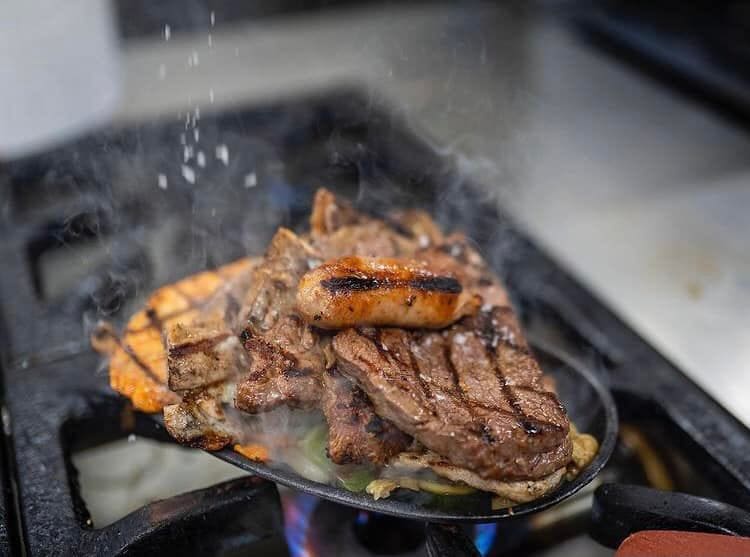
One of the most common challenges when grilling steak is knowing when the grill is too hot or not hot enough. If the grill is too hot, the steak may end up with a burnt crust and a raw interior, while if it’s not hot enough, the steak may overcook and dry out. So how can you tell if the grill is just right?
The answer is using a meat thermometer. This handy gadget will help you gauge the exact temperature of the meat, ensuring that it’s cooked to perfection. If you don’t have a meat thermometer, there’s an alternative method to check the heat. Hold your hand three inches above the grill and count to 1 Mississippi, 2 Mississippi. If you can’t hold your hand there for more than two seconds, the grill is too hot. If you can hold your hand there for 5-7 seconds, the grill is not hot enough.
Internal Temperature for Steak
Rare Steak
A rare steak should have an internal temperature of 125°F. Let your steak rest on the counter for 30 minutes to an hour before cooking, so it can come to room temperature. Sprinkle medium-grain sea salt and pepper while waiting for it to be at room temperature. Rotate and flip the steak often to develop a nice crust when grilling.
Remove the steak from the heat when it’s five degrees shy of your desired temperature, and let it rest on a platter for five minutes to seal in the juices. To obtain an accurate temperature reading, insert the thermometer into the thickest part of the meat and avoid bones or fat. Most thermometers require the probe to be inserted at least 1/2 inch into the meat. With an internal temperature of 125°F, you can enjoy a delicious, rare steak.
Medium-Rare Steak
For those who prefer a medium-rare steak, the ideal internal temperature to aim for is between 130°F to 135°F. It’s important to note that the steak should be removed from the heat source when it’s around five degrees from the desired temperature, as it will continue to cook for a few more minutes after being removed.
To check the temperature accurately, it’s recommended to use an instant-read digital meat thermometer. Find the thickest part of the steak, typically in the center, and insert the thermometer’s probe at a slight angle. Once the temperature stabilizes, the steak can be removed from the heat source and rested for a few minutes before being served. Cooking a medium-rare steak to the ideal internal temperature is sure to result in a flavorful and satisfying culinary experience.
Medium Steak
The recommended internal temperature for a medium steak is 145°F, according to the USDA. To achieve this, it is essential to use a meat thermometer, which should be inserted into the center of the steak, avoiding any bone or fat. Removing the steak from the heat when the thermometer registers 5°F lower than the desired doneness is advisable. This resting time allows the temperature of the steak to continue to rise and ensures that the juices remain inside the meat, making it succulent and flavorful.
The key to cooking the perfect medium steak is to let it rest for at least three minutes before cutting it. This resting time gives the steak time to reabsorb its juices, which helps ensure that it is moist and tender. Whether grilling, pan-frying, or broiling, preparing a perfectly cooked medium steak requires careful attention to internal temperature, cooking time, and resting time.
Medium-Well Steak
When cooking a medium-well steak, paying close attention to the internal temperature is important. A meat thermometer is the best way to ensure your steak is perfectly cooked. The USDA recommends that steaks and roasts be cooked to a minimum internal temperature of 145°F for medium doneness. For a medium-well steak, the internal temperature should be between 150°F and 155°F.
Removing the steak from the heat is essential when the thermometer registers 5°F lower than the desired doneness. The temperature will continue to rise while resting, so it’s crucial to let the steak rest for at least 3 minutes before slicing. Remember to insert the thermometer through the side of the cut tip in the center, not touching the bone or fat. Cooking times and temperatures may vary depending on the preparation method, size, shape of the cut, and desired degree of doneness.
Well-Done Steak
Cooking times and temperatures can vary depending on the preparation method, size, shape of the cut, and desired degree of doneness. The best way to test for doneness in a steak is to use a meat or instant-read thermometer. The thermometer should be inserted through the side of the cut tip in the center, avoiding bone or fat. Once the thermometer reads 5-10°F lower than the desired doneness, the steak should be removed from heat and rest. During this resting period, the temperature will continue to rise. The USDA recommends cooking steaks and roasts to an internal temperature of 145°F for medium, and ground beef should be cooked to a minimum of 160°F for food safety.
Does The Thickness Of The Steak affect The Temperature Of The Grill?
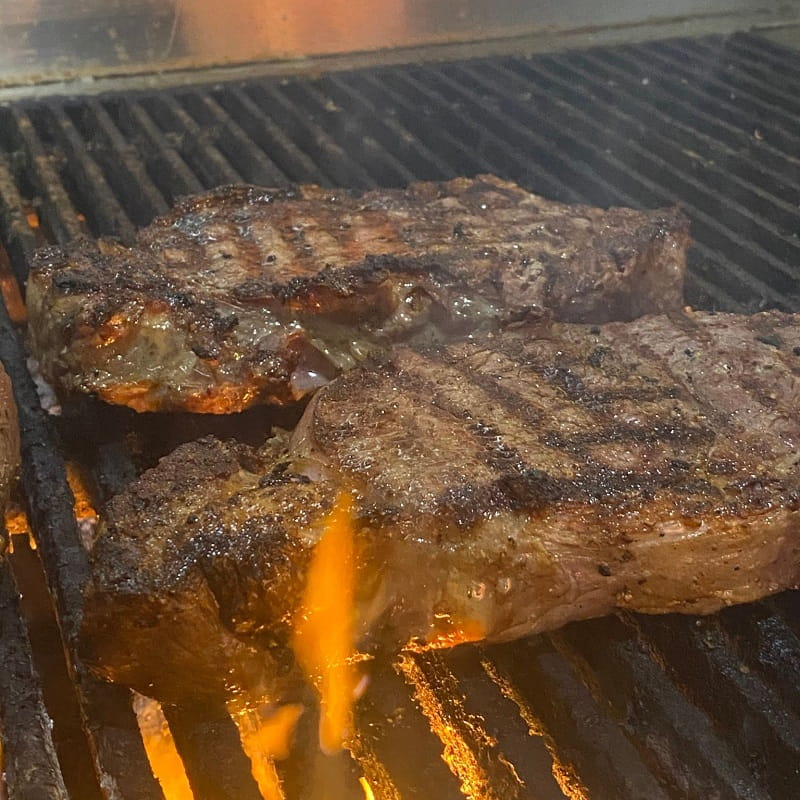
Scientists found that the thickness of a steak can significantly affect the grill’s temperature. A study conducted by meat scientists at Texas A&M University found that thicker steaks cooked at low temperatures or thin steaks cooked at high temperatures resulted in more positive sensory panel traits and higher consumer liking scores.
The study also found that steak thickness and grill surface temperature impact beef identity and brown/roasted flavor aromatics. Thick steaks cooked at 232°C and cut at 3.8 cm thick had the highest burnt flavor and bitter basic tastes. In contrast, thinner steaks cooked at 177°C had a more intense umami basic taste and beef identity. Consumers rated 177°C 3.8 cm steaks higher in beef flavor liking.
Therefore, the cooking process is crucial for positive flavor development, and understanding how steak thickness and grill temperature impact the sensory attributes of the steak can help achieve the perfect grilled steak.
Which Cuts Of Beef Are Best For Grilling?
Certain cuts are sure to impress any carnivorous guest when it comes to grilling beef. T-Bone, Tenderloin, and Top Sirloin are all versatile and juicy cuts that will deliver flavor. But there are also newer cuts to master, such as Flat Iron and Ranch Steak. These cuts are tender, lean, and perfect for grilling.
- One great option for those on a budget is the Chuck Eye Steak, a low-cost alternative to the Rib Eye. It is tender and savory, making it an excellent choice for any grilling occasion.
- The Tri-Tip is a great option for those looking for a lean cut. It is lean yet succulent and buttery in texture.
- The Striploin and Tenderloin Combo is another versatile cut that is great for grilling and can also be used in burgers, tacos, and wraps.
- And for those looking to experiment with new flavors, the Skirt Steak is a great option, with its robust and intense beefy flavor.
No matter which cut you choose, grilling beef is sure to delight the taste buds and satisfy any craving for meat.
How to Grill the Perfect Steak?
As someone who has been grilling steaks for years, I can confidently say there is nothing like the satisfaction of biting into a perfectly cooked steak. I’ve experimented with different techniques and recipes and have finally found the ultimate way to grill the perfect steak every time.
First things first, you’ll need to gather your ingredients. For this recipe, You’ll need:
- Two thick-cut steaks (about 2 inches thick)
- Olive or vegetable oil,
- Salt
- White pepper
- Black pepper
- Butter.
Once your ingredients are ready, it’s time to start.
- Begin by removing the steaks from the refrigerator and any packaging they may be in. Brush each side of the steak with oil to coat, ensuring every inch is covered. Combine the salt, black, and white pepper in a small bowl to make a rub. Rub both sides of each steak with the rub mixture and let them sit at room temperature for at least 30 minutes before cooking.
- Now it’s time to heat the grill. Preheat an outdoor grill to high heat, around 500 degrees Fahrenheit. Once the grill is hot, place the steaks on it and let them sear for 3 minutes per side.
- After searing, reduce the heat to medium-low and continue cooking with the lid closed until the steaks reach the desired level of doneness. For a medium-rare steak, the internal temperature should reach 130 degrees Fahrenheit.
- When the steaks are removed from the grill, immediately top each steak with a tablespoon of butter and tent them with aluminum foil. This will help the steaks retain their juices and flavor. Allow the steaks to rest for 5 to 10 minutes before cutting into them.
By following these simple steps, you’ll be able to grill the perfect steak every time. It’s important to remember to let the steaks sit at room temperature before cooking and rest after cooking. This will ensure the juices are evenly distributed, resulting in a juicy and flavorful steak.
Tips For Maintaining A Consistent Grill Temperature While Cooking Steak
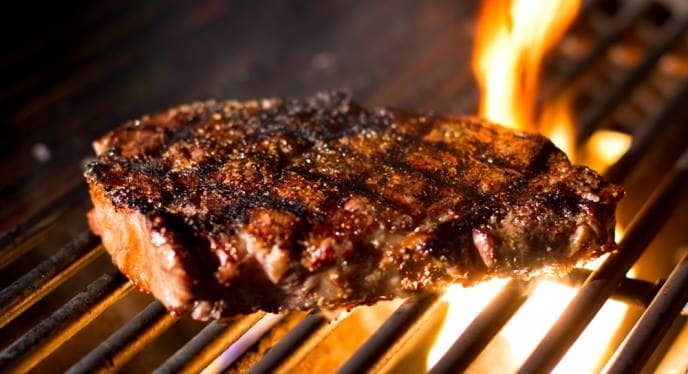
Maintaining a consistent temperature when cooking steak on the grill is key to a perfectly cooked meal. You can follow several tips to ensure you control your grill’s heat.
- First, check your grill’s thermometer to get a rough idea of the temperature. If your grill doesn’t have one, you can purchase a thermometer to place inside the grill.
- Alternatively, you can try the “hand method” by holding your hand above the grill grate and timing how long you can keep it there comfortably to determine the temperature.
- Adjust the heat of your charcoal grill by spreading the briquettes to cool it down and pushing them together to heat it.
- You can adjust the rack or close/open the top vent to control the temperature.
Gas grills are easier to control since you can adjust the knobs. For a lower temperature, turn on one burner and leave the others off while cooking on the offside. Regardless of your grill type, follow the recommended temperature ranges for your recipe to achieve the best results.
What Is The Difference Between Direct And Indirect Heat When Grilling Steak?
When grilling a steak, two types of heat can be used: direct and indirect.
Direct heat involves cooking the food directly over the heat source, such as grilling meat directly over burning coals. This method is ideal for cooking foods quickly, including steaks, burgers, and chicken breasts. Direct heat is also used to create those iconic grill marks on the surface of the food. However, too much exposure to direct heat can result in dry and less flavorful dishes.
On the other hand, indirect heat involves cooking food away from the heat source, such as placing food on the grates to the side of the fuel source. This method is ideal for cooking foods that are more delicate and require longer cooking, including whole chickens, oily fish, roasts, ribs, and briskets. Indirect heat is less intense than direct heat, and heat transfer occurs from the hot air circulating through the firebox.
Setting up heat zones on the grill, with half the grill set for direct and half for indirect heat, allows for greater control over the heat transfer. Knowing when to use direct or indirect heat can affect the outcome of the dish, making it essential for the perfect grilled steak.
What Are Seasonings Recommended For Grilling Steak?
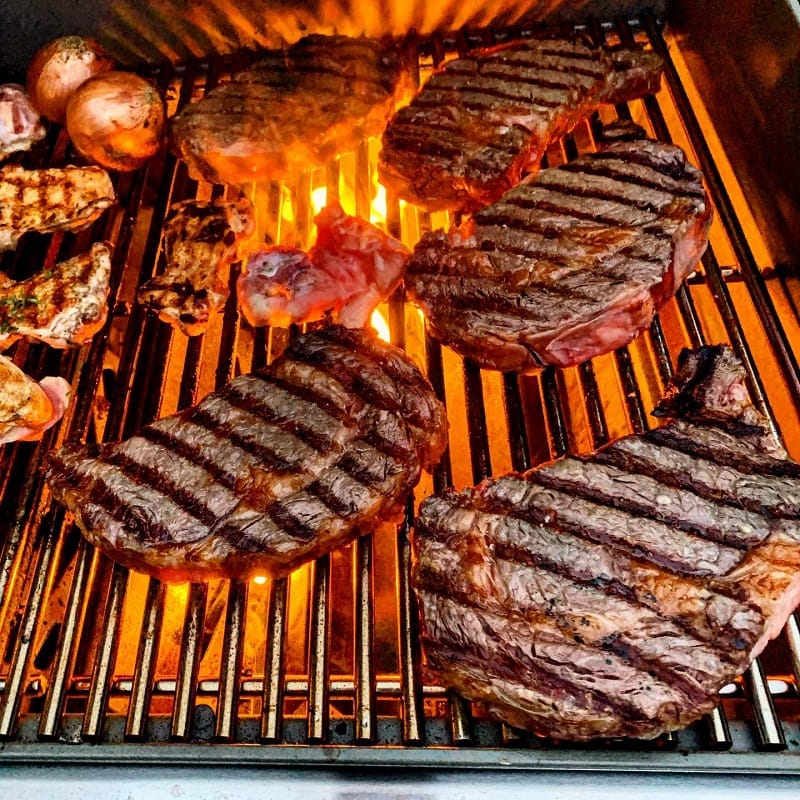
The right seasonings can make all the difference in grilling a steak.
Over time, I’ve experimented with various herbs and spices, trying to find the perfect combination to bring out the meat’s natural flavor. After much trial and error, I have finally narrowed down the best seasonings for grilling steak, and I’m excited to share them with you.
My go-to combination is kosher salt, freshly cracked black pepper, and garlic powder. I find that this trio of flavors brings out the natural taste of the steak without overpowering it. Be sure to season both sides of the meat liberally and let it sit at room temperature for at least 30 minutes before grilling.
If you’re looking to add a little extra flavor, there are a few other seasonings that I highly recommend. One of my favorites is smoked paprika. Not only does it add a smoky depth of flavor to the steak, but it also gives it a beautiful reddish-brown color. I also love to sprinkle on some dried thyme or rosemary for an earthy, herbaceous taste.
For those who like a bit of heat, a pinch of cayenne or red pepper flakes can add a nice kick to the steak. Be careful not to overdo it, as too much spice can overpower the other flavors.
Lastly, don’t forget about the importance of good quality olive oil. Brushing a little bit onto the steak before grilling can help the seasonings stick and create a nice crust on the outside.
How to Buy the Perfect Steak?
While there are plenty of factors to consider when selecting the right steak, I believe that there are a few key things that every meat lover should keep in mind.
First and foremost, it’s important to think about the type of steak that you’re looking for. Are you in the mood for a tender, juicy filet mignon, or do you prefer the richer flavor of a ribeye? Do you want a bone-in steak for added flavor, or would you rather stick with boneless cuts? Deciding on the type of steak that you want will make it easier to narrow down your options when you’re at the butcher shop or grocery store.
Once you’ve decided on the type of steak you want, it’s time to consider the quality of the meat itself. Look for well-marbled steaks with thin veins of fat running through the meat. This marbling adds flavor and helps keep the steak moist and tender as it cooks. Additionally, ensure the steak is bright, uniform, and without discoloration or brown spots.
Another essential factor to consider is the grade of the meat. USDA grading is the most common system used in the United States, with grades ranging from Prime (the highest quality) to Choice, Select, and Standard (the lowest quality). While Prime cuts are the most expensive, they’re also the most flavorful and tender. If you’re on a budget, you can still get a great steak by choosing a Choice or Select cut but be prepared for a slightly less juicy and tender result.
Of course, buying the perfect steak is only half the battle; you also need to know how to cook it properly. Whether you prefer grilling, broiling, or pan-searing, the key to a great steak is to cook it hot and fast. This not only helps to sear in the juices and flavor, but it also helps develop a delicious crust outside the meat.
Finally, remember that the perfect steak is a matter of personal preference. Some people like their steaks rare, while others prefer them well done. Some people like to season their steaks with just a little salt and pepper, while others prefer a more complex blend of spices and herbs. The key is experimenting with different cuts, cooking methods, and seasonings until you find the best combination.
Common Mistakes People Make When Grilling Steak Due To Incorrect Grill Temperature
Here, I will share my experience and expertise on the common mistakes people make when grilling steak due to incorrect grill temperature.
- Not Preheating the Grill: The first mistake people make is not preheating the grill. Preheating your grill is essential to ensure your steak cooks evenly and quickly. If you don’t preheat your grill, it will take longer to cook your steak, and you may not get the desired sear on the outside. Ensure you preheat your grill for at least 15-20 minutes before cooking your steak.
- Not Using the Right Temperature: Another common mistake is not using the right temperature when grilling a steak. Different cuts of steak require different temperatures to cook perfectly. For example, a ribeye steak requires a higher temperature than a flank steak. Ensure you know the optimal temperature for the steak you are grilling and adjust your grill temperature accordingly.
- Not Checking the Temperature of the Steak: While the grill temperature is crucial, it is also essential to check the temperature of your steak while cooking. The best way to do this is by using a meat thermometer. It will help you determine the doneness of your steak and avoid overcooking or undercooking it.
- Not Letting the Steak Rest: Another common mistake people make when grilling steak is not letting it rest after cooking. When you remove your steak from the grill, let it rest for 5-10 minutes before slicing into it. This will help the juices redistribute throughout the meat, resulting in a more flavorful and tender steak.
FAQs
What Type Of Grill Works Best For Cooking Steak?
When grilling a steak, the type of grill you use can significantly impact the meat’s overall flavor and tenderness.
- Charcoal grills are popular among outdoor cooks, as they impart a smoky, rich flavor that many foodies crave. The adjustable air intake and exhaust of a charcoal grill allow for consistent temperature throughout the cooking process, which is particularly beneficial when cooking tougher cuts of meat for extended periods of time.
- On the other hand, gas grills heat up quickly and allow for precise temperature control, which is ideal for achieving a perfect sear on a steak.
- Pellet grills are another option, offering the convenience of propane with the flavor of wood smoke.
Ultimately, the best type of grill for cooking steak is subjective and depends on personal preference. Some steak enthusiasts may prefer the smoky flavor of a charcoal grill, while others may prioritize quick and precise cooking with a gas grill. Ensuring the meat is cooked to the desired temperature, regardless of the grill type, is crucial for achieving a perfect steak.
How Do You Achieve Perfect Char Marks When Grilling Steak?
grilling a steak with perfect char marks can seem daunting, but it is easily achievable with simple tricks. Preheating the grill until very hot (about 500 – 550°F) is crucial to getting a good sear on the meat.
Depending on what is being cooked, lightly oil or sauce the food. Achieving perfect grill marks looks good and can also help gauge when the food is done cooking. However, to get maximum flavor, strive to sear much of the meat’s exterior to a golden brown to caramelize and brown the surface of the meat, resulting in a much richer, delicious flavor.
Therefore, don’t just look for grill marks; strive to sear as much of the meat’s exterior as possible to achieve maximum flavor.
How Long Should You Marinate Steaks Before Grilling?
Experts say the optimal time for marinating steaks is 1-4 hours. Marinating too long can break down the proteins in the meat, resulting in a mushy texture. Additionally, poking holes in the steaks before marinating is not recommended as it can cause the juices to drain out, leading to a less juicy and flavorful steak.
While marinating is not necessary for grilling steaks, it can enhance the taste and texture of the meat. A simple marinade with pantry staples such as olive oil, soy sauce, and Worcestershire sauce can yield flavorful and juicy steaks with minimal effort.
Marinating should be done in the refrigerator to prevent bacterial growth and ensure food safety.
How Long Should You Let Steaks Rest After Grilling?
Resting steaks after grilling is an essential part of achieving a quality dish. Resting meat allows its juices to reabsorb and redistribute, resulting in a tender and juicy steak.
The ideal temperature range for steak is between 120-130 degrees Fahrenheit at the center and 125-140 degrees Fahrenheit at the exterior, and achieving this is crucial. The process of resting depends on the thickness of the cut. Thinner cuts should rest for a minimum of 5-7 minutes, while thick cuts may go up to 10-20 minutes.
Resting time for a steak can be calculated using the timing recommendations, such as resting the meat for 5 minutes per inch of thickness, 10 minutes per pound, or 1 minute for every 100 grams. The Meat temperature rises while resting due to carryover cooking, so it is best to remove the meat from the grill or pan a few degrees south of the desired temperature.
Conclusion
In conclusion, the ideal temperature for grilling steak is around 500-550°F. However, this can vary depending on the thickness of the cut, the type of grill, and the type of steak you’re cooking. By following these tips and experimenting with different temperatures and cooking times, you can achieve the perfect steak every time. So fire up the grill and get ready to impress your friends and family with your grilling skills!
Do you have any questions on how hot should the grill be for steak? Let us know in the comments below.
References:
- https://www.weber.com/US/en/blog/burning-questions/how-to-sear/weber-30583.html
- https://www.certifiedangusbeef.com/kitchen/doneness.php
- https://blog.certifiedangusbeef.com/2016/05/diamond-grill-marks/

Hey readers! Chip Holland here, and I’m a Manager of this website. My passion for writing about it only matches my passion for BBQ. Follow my blog for mouth-watering recipes, tips, and tricks for the perfect smoke, grill, and BBQ. I’m sure you won’t be disappointed!
